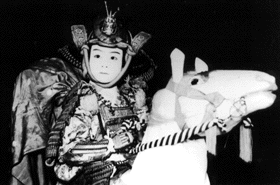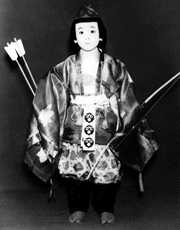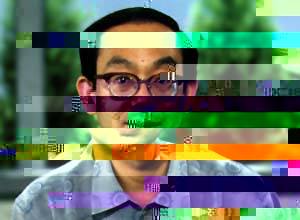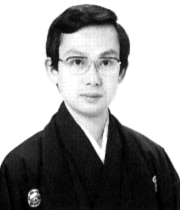Life as a Kabuki actor
Ichimura Manjiro
After I made my stage debut at Kabuki-za in October 1955, the theater became
my playground. I would see what sort of
trouble I could cause as I made my way through the backstage area, the
opening under the stage or even the lobby. Although I sometimes drew the
anger of those around me, since it is not so easy to replace
a child actor once a run has begun, we were treated especially well. One
characteristic of the backstage area was that there was very little distinction for
age in conversations. This produced a unique atmosphere where the children
learned while playing in the adult workplace.

There was a worker at the theater referred to as the "magnet man." One day as
he dragged a magnet attached to a string across the stage, I asked him what he
was doing. He replied that he was picking up any loose nails so the actors
would not step on them and hurt themselves. He also made sure to warn me
not to walk on the revolving stage during the play as it would interrupt the
action on stage. This probably wouldn't happen at the large theaters today, but
in the old days the stages were much smaller and if one were to walk across the
back of the revolving stage, it would cause the front to tilt. These words and
many like them ingrained in my mind the importance of always being aware of
what was happening on stage.
During the second half of the a run, the actors do wig fittings for the next
month's performances. As the copper base is being fit around his head, the
actor creates an image of the role in his mind and consults with the wig maker
about how the hair should be shaped around the edges. This is important as it
helps express the strength or gentleness of the character. During the Edo
period, hairstyles could differ depending on one's profession and status in
society and thus the wig for each character is different. The wig itself is an
important part of forming the character.
 |
I learned much in my youth just by observing: ways to do make-up, how to
wear different kimono, how to wear a sword at one's hip like a samurai, and
even the games of "go" and "shogi." Once I began appearing on stage, my
learning became more active. I started dance lessons, and when I got bigger, I
had lessons in percussion, the three-stringed shamisen, the koto zither and
gidayu chanting.
|
As I grew older, I had the oppurtunity to appear in overseas performances. I
travelled to eight countries, including China and Brazil, and I began to understand the importance not just of the vague concept of cultural exchange,
but for the link established between people. It is extremely expensive to put
on Kabuki plays overseas and since the official purpose of such trips is "cultural
exchange," the destinations are different each time. Added to that the fact that
the trips tend to be quite short, it is hard for the performances to provide little
more than superficial exchange.
I began to think of the large number of foreigners who now live in Japan and
came up with the idea for "Kabuki for Everyone" in 1992 to provide them with
an inexpensive, easy to understand and enjoyable introduction to Kabuki in the
hopes that they would come to understand Japan better. Each show includes
two popular plays from the Kabuki reperatory proceeded by a one hour
demonstration and explanation. This demonstration is given in Japanese,
English and one other language. The first performance featured Chinese and we
invited Japanese who had been orphaned in China after the war to help introduce them to their native culture.
During my trip to Brazil, I took a one-day trip to see the Iguas Waterfall, the
largest in the world, about 1000 km. from where I was staying in Sao Paulo.
My interpreter, a Brazilian of Japanese ancestry, said how Japanese was
becoming harder for him to understand as it had more and more borrowed
words. The first time he heard "wain" (wine), he tried hard to match it to other
words of Japanese he knew. If they had just said "budoshu" (the native
Japanese word for wine which literally means 'grape liquor'), he would have
understood immediately. He had grown fond of the Japan as told to him by his
parents and grandparents and seemed to have romanticized about how wonderful a place it was.
Now, several hundreds of thousands like him have come to work in Japan. Yet
incidents have happened to ruin their image of the country, making them think
of the Japanese as a very cold people. To help make their stay more enjoyable,
we added Portuguese interpretation to the demonstration of the second performance. Then, for the third performance we used French and invited
members of the Vietmanese and Bangladesh community.
Having gained a position as an economic superpower, Japan is being asked by the global community
what contributions it can make to the world. I have also wondered what I may
do as a Kabuki actor. It is not my place to change the traditions of Kabuki, but I
can try to create a new feeling for a play based on the techniques and efforts of
the playwrights and great actors of the past. Yet before that, before Kabuki
becomes nothing more than just another dying folk art of the far east, I would
like to show the world of its greatness, and of the warmness of the Japanese
heart.
It is important to spread this message to as many people as possible, including
the Japanese. Last year an exhibition of pictures of many of my roles was held
at a department store in Tokyo and at that time we also created a CD-ROM
containing video, sounds and explanations of Kabuki so one could discover and
explore Kabuki in a game-like atmosphere. This web page you are reading now is an
extension of that idea and an experiment to introduce Kabuki to the whole
world.
 |
It is my hope that these efforts will not only bring Kabuki closer to the world,
but that I will also be able to come closer to those that explore these pages.
|
For
more information, please send mail to Kabuki Master







